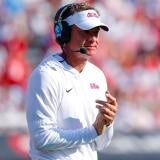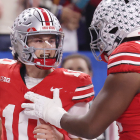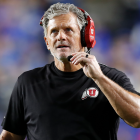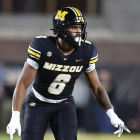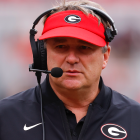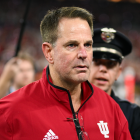Inside the chaotic transfer portal recruiting process consuming the college football offseason
Nearly 2,000 players entered the transfer portal after the 2022 season, and there's no sense of it slowing down
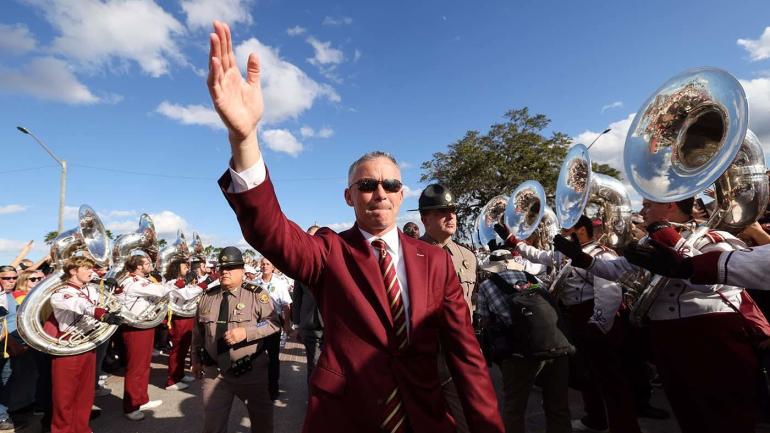
After four years at Stanford, defensive back Jonathan McGill decided it was time for something new. The Coppell, Texas, native excelled with 17 passes defended and 116 tackles during a strong career; he even earned captain honors as a senior. But after coach David Shaw resigned and ended his 12-year run with the Cardinal, it was time for McGill to move on as well.
Just after 6 p.m. local time on Nov. 28, 2022, two days after Stanford's final game of the season and Shaw's subsequent resignation, McGill sent out a tweet announcing his intent to enter the transfer portal as a graduate transfer. Stanford's compliance staff alerted him that it would take some time before his name ultimately showed up in the portal, so he settled down to play video games.
Suddenly, his phone went crazy.
Ding. Ding. Ding. Ding. Ding. Twitter DMs. Instagram DMs. Texts. Phone calls. Recruiting coordinators. Graduate assistants. Coaches he knew. Schools he did not.
"My phone was blowing up," McGill told CBS Sports. "A lot of different schools -- D-I, Power Five, non-Power Five, [FCS]. It was crazy just the amount of attention and amount of people that reached out."
Virginia cornerback transfer Fentrell Cypress II was an overlooked high school recruit with offers from only a handful of ACC schools. But when he entered the transfer portal on Dec. 5, 247Sports rated Cypress as the No. 4 overall transfer in the nation. Similarly, schools came calling instantly.
"It was kind of surprising how hyped I was getting during the moment," Cypress said during a January media availability at Florida State, where he ultimately transferred. "At the same time, it was a blessing. I just tried to take it day by day and go through the process, and [I] was just thankful for this blessing that God had given me. But it was overwhelming."
Over a six week period at the conclusion of the regular season, nearly 2,000 FBS players -- from seasoned veterans like McGill to redshirt freshmen seeking playing time -- entered the transfer portal in search of new homes.
Amid the chaos, behind the scenes, college football coaching and support staffs are tasked with cutting through all the noise in hopes of finding diamonds in the rough.
Welcome to the transfer portal carousel.

Creating a strategy
The transfer portal launched in 2018 to provide a one-stop shop for transferring athletes and programs to connect. The combination of the portal, the soon-passed one-time transfer rule allowing all athletes to switch programs without sitting out a year, and an NCAA-granted additional year of eligibility amid the COVID-19 pandemic led to the portal becoming a cultural force.
Following the 2021 season, more than 3,000 FBS players entered the portal. The number this offseason has already eclipsed 2,000 with another portal window set to open near the conclusion of spring practice. On the other side of the viral tweets and announcements are scouts and recruiting staffs working overtime to get up to speed.
Florida State utilized a strong transfer class ahead of the 2022 season to reach 10 wins for the first time since 2016. The Seminoles have doubled down on the strategy in 2023 with a top-five transfer class, Cypress included.
Given the quick turnaround, efficiency is key. Staffs monitor social media and the transfer portal for new entries. When there's a player that piques interest, the staff gets an alert. Oftentimes, a program may have familiarity with a player, perhaps from recruiting them out of high school or a coach previously being in the same program. Staffers also do legwork to determine why a player is transferring and whether there are any red flags.
"The initial evaluation happens very quickly, but we also also don't want to pin ourselves in a hole that, yes or no, we're going to take someone right then and there," said Darrick Yray, general manager of personnel at Florida State. "The initial evaluation to make sure that it is someone we're going to recruit happens quickly, but the evaluation never stops from the moment that they set foot on campus."
Notably, FSU had an early eye on then-Albany defensive end Jared Verse after watching his film while preparing for Syracuse in 2021. Its prior knowledge allowed the Noles to be one of the first to offer Verse a scholarship. Getting efficient information with a player allows the staff to make a recruiting decision within hours.
"Sometimes even minutes," said Yray.
Prior relationships and interactions remain the primary driver of transfer portal movement. Look no further than Arizona State, which ranks as the biggest class in the nation with 27 commitments. Cornerbacks coach Bryan Carrington worked on recruiting staffs under Tom Herman at Texas, Sonny Dykes at TCU and Clay Helton at USC. Four players were direct members of Carrington's recruiting work at those two schools, including Longhorns transfers Prince Dorbah and Troy Omeire.
But for a first-year staff like Kenny Dillingham's at ASU, spreading a wide net is key. Impressive athletes from major schools -- Oklahoma's Clayton Smith, Notre Dame's Drew Pyne and Oregon's Bram Walden -- WERE easy takes. Elsewhere, Arizona State's coaches got a report every day with players who jumped in the portal listing their names, schools, hometowns, starts and snaps.
Experience is a premium, and the transfer exemption allows programs to compile heavy transfer classes while still keeping their rosters balanced.
"If you're a one-year guy, either you were a draft pick or you fit an immediate need," Carrington said. "Otherwise, we're going for a guy with three years [eligibility remaining who is] in the portal. We viewed the guy that has three years in the portal as a freshman because those are guys that allow us to buy time and build the foundation of our program."
Many hands are involved in the process along the way. The recruiting staff or a graduate assistant might identify a player. In many cases, a position coach will give the green light to actively recruit. A head coach or director of personnel could approve the commitment. The programs that best coordinate this process are the ones with the highest hit rate. The ultimate goal is creating as deep and talented a roster as possible to withstand the rigors of a long college football season.
"I want the toughest competition we face every year to be on the practice field," Florida State coach Mike Norvell told Patrick Peterson and Bryant McFadden on CBS Sports' All Things Covered Podcast. "Having that urgency of having to produce when your number is called ... when you have depth and talent at all positions, it's a never-ending flow of being able to attack. That's what we aspire to be."

Business-like recruiting
When staffs decide to pursue a player, the full-court press is on.
"For high school [recruits], relationships might be going for three or four years," Yray said. "If you're looking at the transfer portal, that might be done in less than a week."
North of 20 schools reached out to McGill with the vast majority of messages coming in the first 24 hours. That first night alone, he spoke to several assistant coaches, along with SMU coach Rhett Lashlee. There was no time to waste.
In the past, players might sit back and consider transferring a second or third time. However, the NCAA passed legislation in January limiting immediate eligibility for multiple-time transfers, making the transfer decision much more binding. The second go-round for transfers tends to be more of a business decision. Instead of focusing on conference or facilities, playing time and development is front of mind. Players also generally wait until they finish their undergraduate degree so they can transfer as a graduate student and be eligible to play immediately.
"The high school kid wants to know if y'all have flat screens in the locker room, how many uniform combinations you have, how many people does the stadium hold?" Carrington said. "The transfer is going for an opportunity. He doesn't care what you've got in the locker room. He's been sitting on the bench at Georgia for three years and wants to go somewhere where he can get on the field and have an opportunity to earn money on Sundays."
Ultimately for McGill, familiarity won out. McGill was committed to SMU as a high school recruit before Stanford entered the picture. Lashlee was offensive coordinator on that squad. Lashlee called McGill the same night he entered the portal, which emphasized how interested SMU was in his services.
"I'd say, honestly, one of the best things that they do is establish good relationships," McGill said. "From the moment I hopped on the phone, they were really, really good people. ... Nowadays, I was really just looking for the best people and the best culture."
SMU rode the transfer train to its best five-year stretch since the Pony Express days of the early 1980s under Dykes, and Lashlee has kept things rolling. In 2023, the Mustangs put together the No. 9 transfer class in the nation, featuring underclassman blue-chip transfers like Texas A&M offensive tackle PJ Williams and Miami running back Jaylan Knighton. No other Group of Five team fielded even a top 50 transfer class.
After entering the portal in late November, McGill hoped to make a decision by Christmas so that he could focus on the many logistical issues around actually moving to a new school. He had to find an apartment and a car. Oh, he also had to fill out applications and get letters of recommendation to be admitted to graduate school at a major national university.
"The bad part about it is it does kind of make athletes have to rush into some decisions, especially those who want to start classes in the December period," McGill said. "Honestly, I felt a sense of pressure when I first hopped in. I was entertaining a whole bunch of schools, talking to everybody. ... I wouldn't necessarily say I rushed into a decision, but I can see how other people rush into decisions just based on the timing of things."
Ultimately, McGill was on campus in time for the start of SMU's spring semester on Jan. 17, less than two months after deciding to leave Palo Alto, California. He will have a strong chance to compete for a vacant safety or nickel spot; SMU's defensive backfield started three transfers last year and recently sent converted running back and UCLA transfer Brandon Stephens to the third round of the 2021 NFL Draft. All the boxes are checked.

Flipping a roster
In recent years, the transfer portal has helped teams quickly flip their rosters. Michigan State rode a star-studded transfer class to an 11-win season in 2021. USC rebuilt under Lincoln Riley in one offseason by adding eventual Heisman Trophy winning quarterback Caleb Williams and Biletnikoff Award-winning wide receiver Jordan Addison. TCU rode to the College Football Playoff National Championship thanks to key transfers: safety Mark Perry, linebacker Johnny Hodges and center Alan Ali.
Take a look at the top of the 247Sports Transfer Football Team Rankings, and you will see numerous teams looking for a fresh slate. Colorado is No. 1 as Deion Sanders begins his tenure as coach. Auburn sits at No. 5 behind Hugh Freeze's arrival. Oklahoma searches for a reset in Year 2 of the Brent Venables era.
For programs that do their due diligence, there's value to be found. Five of the top 17 prospects in the 2023 NFL Draft Prospect Rankings are transfers. So was Outland Trophy winner Olusegun Oluwatimi. With the steadily influx of players in the portal, those numbers are sure to rise.
"You're looking for the best fits for what your roster calls for," Yray said. "At the end of the day, are they a fit, and could they potentially upgrade us for this year? There's not a hard cap one way or the other, but ultimately we decide what's the best fit and best decision for Florida State."
Of course, the system isn't perfect. The NCAA tracked 1,582 scholarship FBS football players who entered the transfer portal during the 2021 calendar year. Only 60% transferred and received a scholarship at their new school. The other 40% either transferred to a spot without an athletic scholarship or did not enroll at another NCAA school for athletic purposes.
None of this is to claim transfer recruiting guarantees success. Only three of the top 10 teams in 247Sports' 2022 rankings won at least 10 games. Oklahoma, Arkansas and Alabama each finished with worse records despite landing top transfer classes.
Help on the way?
The NCAA attempted to address the widespread transfer epidemic by creating limited windows in which players can enter the transfer portal. Now, they can only add their names immediately after the regular season or once spring practice concludes.
The change has streamlined the process, helping ensure that targets and suitors are on the same page. It's also taking at least some stress off coaches and staffs that have seen their offseason work nearly double in recent years.
Regardless, the transfer portal is here to stay, and the programs who manage it best will earn tangible results.
"I'm a believer that one man's trash is another man's treasure," Carrington said. "Having been at Texas, you've got a surplus of athletes on your roster and a lot of people can't juggle. Those kids are a gold mine for me because I know that those kids didn't have a home.
"Now, they have an opportunity to thrive."







